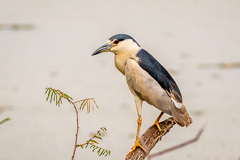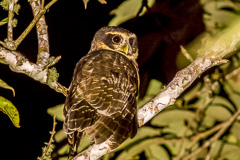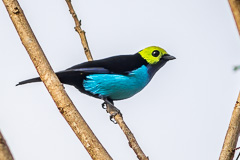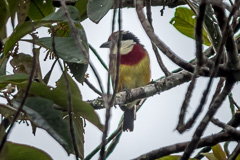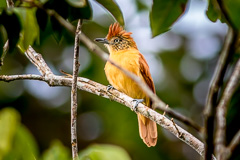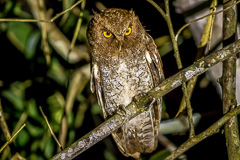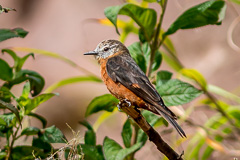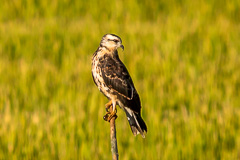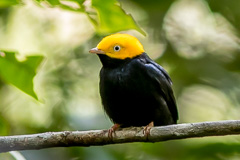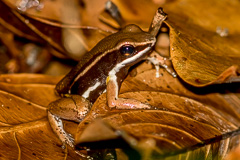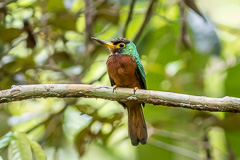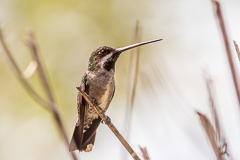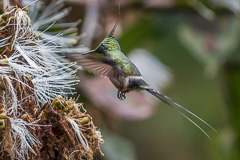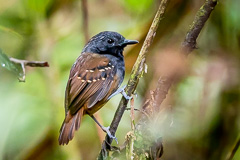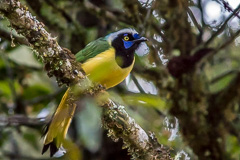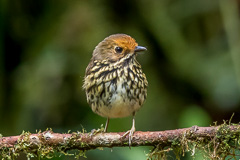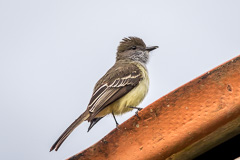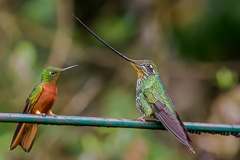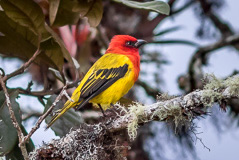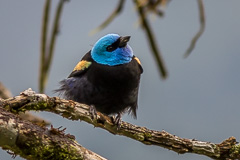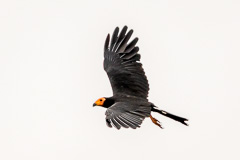Overview
Dates: |
29 July - 11 August 2018. |
With Mike Danzenbaker, Peter Kaestner and Alain Jortay. This, the second part of a two-part Peru clean up trip, immediately followed our successful part I of central Peru. As this was a fixed departure, by Manu Expeditions, we had no direct input to the itinerary. The trip was aimed firmly at the highly sought after, enigmatic, and often difficult specialities of northern Peru, such as Marvelous Spatule-tail, Long-whiskered Owlet, Scarlet-banded Barbet, Cerro Azul Antbird and White-masked Antbird. Our guide Alex Durand, and cook Abuelio, were the same as had accompanied us on part I. One thing particularly evident, no doubt the result of northern Peru being so popular with visiting birders, was the lack of responsiveness of birds close to key birding spots. It's far better to bird well away from the more easily accessed areas.
Itinerary
28 Jul. Having completed part I yesterday and overnighted at the airport, a day of repacking, email, trip report writing, photo processing and general preparation for the north. As northern Peru would not be so cold, most of our repacking was simply jettisoning the heavy high-altitude clothing we'd needed in central Peru.
29 Jul. A relatively late lie in till 06:00, a large breakfast buffet, then a short walk to the terminal where we attempted to check in for our 09:30 Latam Airlines flight to Tarapoto. However, a terrible start to the trip as despite having confirmed tickets and seat reservations, three of us had been unceremoniously bumped off the flight due to over-booking. An hour and a half of discussion, standing around and talking with various staff eventually secured us on the next flight at 13:30. Compensation for this hassle was a paltry $20 that we had to fight for as cash, as usually this would only be paid into Peruvian bank accounts. No doubt they had chosen foreigners to be kicked off the flight so as to minimise reputational damage and compensation. Certainly we would not be recommending flying with Latam again!
Eventually arrived in Tarapoto at 15:00, where we met up with Alain and Alex. The change in temperature hit us immediately, with the balmy 34°C lowlands in strong contrast to the cold Andean temperatures we'd been experiencing the previous three weeks. It was very pleasing to be reunited with our driver, Walter, from our successful trip to Manu Road last year. A two plus hour drive to Bellavista where, with the last 30 minutes of light, we stopped at scrub adjacent to the river, finding Northern Slaty Antshrike, Grey-breasted Martin and Boat-billed Flycatcher. Due to limited dining facilities in town we ate at the pizza bar next to the hotel - surely the world's worst pizza, but what to expect in the Amazonian lowlands middle of nowhere? They did at least have good cold beer!
30 Jul. Another repack, transferring all our gear into the vehicles that would drive us to Flor de Café. Due to the horrendous condition of last 13 kilometres of this road, these are well jacked-up pickups, with mud tyres and very experienced drivers. Left Bellavista at 06:30, making several birding stops in the lowlands en route, finding Speckled Chachalaca, Hoatzin, Sapphire-spangled Emerald, Pearl Kite, Swallow-tailed Kite, Green-backed Trogon, Yellow-billed Nunbird, Chestnut-eared Aracari, Spot-breasted Woodpecker, Blackish Antbird, White-lored Antpitta heard, Mishana Tyrannulet and Red-billed Tyrannulet. |
The first 60 kilometres of this drive are on graded dirt road, and it's only above El Triunfo that the serious off road begins. Quite simply, this has to be one of the worst roads in the world, and difficult to described just how rutted, muddy and horrendous it is. Good fun though with experienced drivers and capable vehicles. Fortunately, this morning no rain was falling so we never actually become stuck. Arrived late afternoon at Flor de Café, though birding along the approach road was extremely quiet, so not a sniff of Scarlet-banded Barbet.
The village of Flor de Café is remote, but rapidly expanding, with forest clearance running apace, and is yet another site where one wonders if birding five years hence will be worthwhile. The only accommodation in the village was described as very basic, but to be honest was much better than most of the smelly, cheap accommodation birders often have to put up with in Indonesia. After dark, a night session was rewarded with Band-bellied Owl, but Foothill Screech Owl proved impossible to access in the dense vegetation. 31 Jul. Village life of course meant roosters and dogs overnight, without which it would have been very peaceful. At daybreak the weather looked rather ominous with low cloud and rain looking a strong possibility. An early start up the main trail, climbing though the cut-over forest above the village. Very slow going due to the knee-deep mud, with us having to take extreme care not to fall with optics. Certainly one of the worst trails we'd ever had the pleasure of climbing. And just to make it interesting rain at 09:30 hampered our progress further. However, around 11:00 with the showers easing a flock containing two Scarlet-banded Barbet appeared. Much to our collective relief. Other highlights of the morning were a disappearing Foothill Schiffornis and Yellow-throated Spadebill. Finally, at 11:30 the real rain arrived, and the heavens opened. Having sheltered for 30 minutes hoping for it to abate, we gave up and started our decent in the downpour. If we thought coming up was difficult, now things were getting really slippery and unfortunately it was only a matter of time before someone made a slip and decorated their optics with mud and lost their rubber boots. Fortunately, no one was seriously injured though one person from another group experienced a nasty knee sprain. The dangers of this trail should not be underestimated. Rain had just about ceased by the time we had returned to the accommodation, and after a rapid clean up we were out again, on a lengthy walk in the opposite direction heading to forest beyond the coffee plantations. Here. with the help of a local guide, we had excellent views of the recently described Cordillera Azul Antbird. At dusk we again tried for Foothill Screech Owl where, owing to Alex's great skill, we had walk-away, point blank views of a bird in low thick vegetation. 1 Aug. Thankfully we'd been successful with the Scarlet-banded Barbet yesterday, otherwise we'd have been leaving without it. Two nights here was cutting it fine. We left at 06:45 and birded first few kilometres and the road down the mountain. Yesterday's rain had made the going much more difficult, and we already had one vehicle stuck after 200 metres. Some nice tanager flocks early in the day, plus two targets found - Jet Manakin and Blackish Pewee. Part way back one of our vehicles came to a grinding halt with one of the front wheels locking up. Although this felt rather serious, with visions of us stuck on the mountain the remainder of the day, the drivers evidently had much experience with field repairs and had dismantled and rebuilt the wheel and braking system, including the brake transmission system within 30 minutes and had us back on the road - amazing. We finally reached Bellavista at 13:00, transferred back to our comfortable van and headed back to Tarapoto, stopping en route for Ashy-headed Greenlet and Sulphur-bellied Tyrant-Manakin. This last stop was basically a catch up from our delayed beginning of the trip when we'd been thrown off our flight, so was rather short, though successful. |
2 Aug. A 06:00 departure and straight up the winding road through the Cordillera Escalera Regional Conservation Area just outside town. Our first stop, the pass at 1,000 metres, was very fogged in, but perseverance gave us views of several Wattled Guan, White-throated Woodpecker and Ocellated Woodcreeper through the mist.
Dropping down the other flank of the mountain it immediately cleared, with cool temperatures and bright sun. No luck in finding Plumbeous Euphonia, though a good few Cliff Flycatcher in evidence, plus White-tipped Swift. |
Farther down we spent several hours at the hermit feeders, with White-necked Jacobin, Gould's Jewelfront, Great-billed Hermit, Blue-fronted Lancebill, Black-throated Mango, and Koepcke's Hermit. A walk inside the forest produced Red-stained Woodpecker, Plain-brown Woodcreeper, Grey-crowned Flatbill, Banded Antbird and Golden-headed Manakin. After lunch we dropped lower, searching for Dotted Tanager, but only Yellow-bellied Tanager found, that made us realise how easy it would be to string Dotted Tanager here. Dodging showers in the lowlands we tried, but failed, to find Point-tailed Palmcreeper. Onward into the hot lowlands at Yurimaguas, and overnight by the river. |
3 Aug. Our charter flight to San Lorenzo, although scheduled for 08:00, actually departed after 09:00. Note that total baggage allowance, including optics, on this flight is limited to 10 kilograms. Good that it's hot in the lowlands so nothing in the way of warm clothing required. A short 40 minute flight, checked into a simple hostel, early lunch, met up with Eric the local guide, then jumped onto motorcycle taxis to the main White-masked Antbird stakeout. What a bone-shaking ride - only seven kilometres but felt like twenty.
Several hours in the hot, sweaty forest here and we soon realised how difficult seeing this bird was going to be. Shy in the extreme, with thick undergrowth. Although we heard a couple, none were remotely visible, and while trying to creep closer they simply disappeared. Other species included Yellow-billed Jacamar, Bat Falcon, Orange-cheeked Parrot, Cinereous Antshrike, Peruvian Warbling Antbird and Amazonian Plain Xenops. Surprisingly, the simple restaurant near our hostel was one of the best places we ate in Peru. A typically, restless night, with street noise and music running through until 04:00. 4 Aug. Evidently life doesn't start too early in San Lorenzo, and we had to wait till 06:20 before our motorcycle taxis arrived - no doubt the drivers suffering from last night's festivities. Returned to the same spot as yesterday, and spent an equally frustrating time chasing shadows. Following a late lunch in town we headed out of town in the opposite direction to try a different spot for the antbird. This spot is likely far less popular with visitors as it requires a three kilometre walk across open plantations to access decent forest. This time we were much more successful, with a pair of White-masked Antbird seen briefly perched in the open. Returned to town late and would have had a celebratory beer had the restaurant not run out. Another hot, noisy night. |
5 Aug, With a couple of hours to spare at daybreak, we walked through town to the river edge at the rear of the market to scan across the Marañon River. A pair of Horned Screamer were the biggest surprise. Other than that a collection of usual lowland birds such as White-winged Parakeet, Cobalt-winged Parakeet, Brown-breasted Martin and Drab Water Tyrant. At the airfield, more flight issues, with our return charter cancelled due to insufficient passengers flying into San Lorenzo. The only way to ensure it flew was to pay for two empty seats to fly the plane in. More hassles from Peruvian airlines! We finally arrived back at Yurimaguas at 11:00, from where we drove back over the Cordillera Escalera, stopping successfully for Plumbeous Euphonia. Also an interesting stop at Quiscarrumi for Oilbird. We arrived at Waqanki Lodge just before dusk.
6 Aug. Breakfast at 05:45 with calling Rufous Nightjar just behind the restaurant. Good weather to start the day, so we simply took the main trail into the mountain forest. Unfortunately as we had only a single day here, and too many specialities to find, we had insufficient time to slog to the top of the ridge for Ash-throated Antwren, so concentrated on lower altitude targets such as Fiery-throated Fruiteater and the recently described Painted Manakin, both of which successfully found, though Scarlet-shouldered Tanager was not. Generally an excellent morning's birding that also included Rufous-crested Cocquette, Western Striolated Puffbird, Lafresnaye's Piculet and Plain-winged Antshrike. |
The afternoon was taken up with a very unsatisfactory search for Varzea Thrush, that is allegedly common at Waqanki. However, try as hard as we could, we could never quite convince ourselves of a legitimate individual.
The cynics amongst us would say this bird is heavily strung here. An evening owling trip produced Rufous Nightjar and Tropical Screech Owl for some. Our one day here was totally inadequate, as it would be easy to fill three day or more birding this area. 7 Aug. An early start at 04:30 to drive the two hours to Aguas Verdes for dawn. Our first stop was the excellent Arena Blanca private reserve. At the hide, in the early morning gloom, a nice series of visitors to the feeder, with Little Tinamou, Cinereous Tinamou, Rufous-breasted Wood Quail and Ruddy Quail-Dove. Following this feast, another couple of hours were spent in the immediate vicinity with its hummingbird feeders. The horribly named Northern Chestnut-tailed Antbird was a nice addition, plus Wire-crested Thorntail and Golden-collared Toucanet. Back at the vehicle we had another abortive attempt at Varzea Thrush in the adjacent forest before heading into the hills above in search of Ash-throated Antwren. No luck at all with that, though we did finally obtain half-decent views of Varzea Thrush. We then completed the drive to Abra Patricia, arriving by 17:00, immediately heading down one of the trails in search of Long-whiskered Owlet. Despite standing around for a couple of hours in a spot where the bird had been found yesterday, nothing heard. |
8 Aug. A pre dawn attempt for White-throated Screech Owl resulted in a single bird calling distantly. We then joined the ranger on his early round of antpitta feeding, with Chestnut Antpitta and Rusty-tinged Antpitta on offer. The remainder of the morning spent along the roadside leading to the lodge, with success in finding Royal Sunangel and Bar-winged Wood Wren, but not Lulu's Tody-Flycatcher.
Mid afternoon we headed down to the hummingbird feeders below, adding Greenish Puffleg and Violet-fronted Brilliant to the list. A late afternoon walk with the owner to the feeding area of Ochre-fronted Antpitta was a highlight of the trip. Well the bird was, not the walk. After dark we took a long, difficult three kilometre walk from the Lodge to search for Long-whiskered Owlet that, thanks to Alex's expertise, we found at close range, and definitely another highlight of the trip given how difficult this owl has now become to find. |
9 Aug. A long slog up the the hillside at San Lorenzo in search of Pale-billed Antpitta, was not helped by heavy rain mid morning making the stones on the trail extremely slippery. Surprisingly this species is only categorised as Near Threatened, especially given that this is currently the only known site and deforestation is happening before your eyes. In all, we heard about six individuals, though seeing one required finding a way into the dense and steep vegetation, sitting and waiting. A task that took us almost six hours.
Other birds found on the hike included Red-hooded Tanager, Amethyst-throated Sunangel, Aplomado Falcon, Golden-plumed Parakeet and Russet-mantled Softtail. Onward to Huembo, where we arrived, later than planned, at 16:00. This reserve has been set up for Marvelous Spatule-tail, but it wasn't nice to hear on arrival that birds were not currently visiting the feeders. However, we presevered and at the eleventh hour a male Marvelous Spatule-tail made a brief two second appearance. An early evening hunt for Cinnamon Screech Owl was unsuccessful. 10 Aug. We'd planned on pre-dawn owling, but that was knocked on the head by heavy rain all night. A wet morning spent around the lodge, during which we eventually found Lulu's Tody-Flycatcher. During our return to Tarapoto we made several stops, especially around El Afluente where we lucked into Ecuadorian Piedtail, Speckle-chested Piculet and Vermillion Tanager. Mid afternoon in paddies near Rioja we finally achieved success with Point-tailed Palmcreeper as well as Black-billed Seed Finch and Pale-eyed Blackbird. A seemingly endless drive to Tarapoto, arriving 19:15. |
11 Aug. With a couple of hours to spare before our flight we birded fields edges and scrub around Laguna de Ricuricocha close to town. Birds included a large number of Comb Duck, Dark-billed Cuckoo, Short-tailed Swift, Spotted Rail, Black Caracara, Green-backed Trogon, Barred Antshrike and Pearly-vented Tody-Tyrant. Nice to discover we were not bumped off the Latam flight to Lima, where we took at day room at the airport in preparation for the late evening departure home. 12 - 15 Aug. A grueling series of flights home, from Lima to Houston, San Francisco, Hong Kong and Chiang Mai. An exhausting but successful conclusion to our trip. |
Galleries
Bird images from this, and other, birding trips.
Travel images from this, and other, birding trips.

